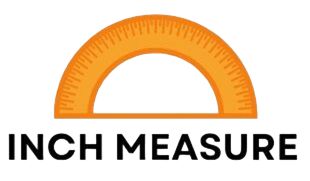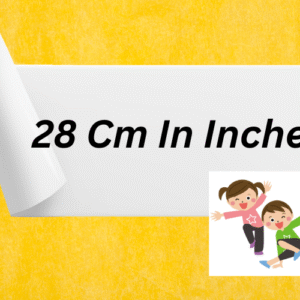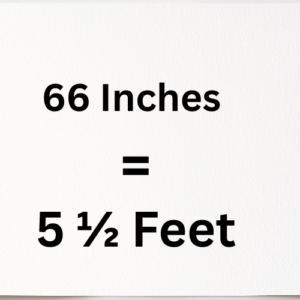Have you ever tried to picture how long 6 inches really is without using a ruler? It’s harder than it sounds. Six inches might seem small, but it’s a size that quietly shows up everywhere — from your phone and wallet to kitchen tools, clothes, and even small home projects.
Knowing what 6 inches looks like can make everyday tasks much easier, like measuring space, shopping online, or planning a quick DIY fix. It’s one of those practical lengths that’s useful more often than you might think.
In this guide, we’ll take a simple look at how long 6 inches is through real-life examples, easy comparisons, and quick conversions. By the end, you’ll have a clear picture of this measurement and how it fits into daily life.
What Is an Inch? A Quick Refresher

Before diving into 6 inches, it’s helpful to understand the inch and its role in both everyday measurements and various industries.
The inch (in) is a unit of length in the imperial system, commonly used in countries like the United States, Canada, and the United Kingdom. It is defined as 1/12th of a foot, which means there are 12 inches in one foot. The inch is also equivalent to 2.54 centimeters in the metric system.
The inch plays a significant role in engineering, fashion, construction, and technology, among other areas. It is often used to measure small lengths in a precise and convenient manner.
Historical Context of the Inch
The history of the inch dates back to ancient civilizations. The original length of an inch was derived from the width of a human thumb, with historical records showing it as the measurement used by the ancient Egyptians and Romans. However, it was the British Imperial System that standardized the length of the inch as we know it today.
Interestingly, the modern inch is based on the international yard, which is defined as 0.9144 meters. The inch is exactly 1/36th of a yard.
This historical understanding is essential when measuring items or working on projects that require precision, especially when using imperial measurement systems or items originating from the UK or US.
How Long Is 6 Inches? Visualizing the Measurement

The main question we need to address is: How long is 6 inches? To help you visualize 6 inches, let’s explore several detailed comparisons that make it easier to understand its size.
The Length of a U.S. Dollar Bill
One of the best ways to visualize 6 inches is to think of the size of a U.S. dollar bill. A U.S. dollar bill measures exactly 6.14 inches long, making it almost the same as 6 inches. This comparison is incredibly useful since most people are familiar with the size of a dollar bill.
- International Comparison: While U.S. bills are used as the standard in the U.S., other currencies like the Euro or British Pounds are slightly different in size but close enough to 6 inches. Therefore, whether you’re handling American currency or similar paper bills from other countries, you can always use the dollar bill as a 6-inch reference.
This comparison is particularly handy when you’re thinking about how to space or measure things like documents, photos, or small items. For example, in many printers, the 6-inch size can be the paper width for certain custom print jobs.
Standard Smartphone Width
Another common comparison is the width of a smartphone. A typical smartphone, such as an iPhone 12 or Samsung Galaxy, has a width of about 2.8 inches. If you lay two smartphones side by side, you get a total length of about 5.6 inches, which is very close to 6 inches.
This makes smartphones a handy reference when visualizing 6 inches. Additionally, some older small-screen mobile phones are even closer to 6 inches, with compact sizes that align closely with this measurement. Smartphones are integral in modern life, and understanding their size in inches helps you better judge screen sizes, case dimensions, and accessory compatibility.
- Phone Screens: If you have a 6-inch screen smartphone (such as the iPhone 6 or Samsung Galaxy S8), this is a common size for a phone. The 6-inch measurement is ideal for devices that are large enough to watch videos or read comfortably but still compact enough to fit into a pocket.
A Standard Paperclip
A standard paperclip measures about 1 inch long. So, if you line up 6 paperclips in a row, you will have a total of 6 inches. This comparison is great because paperclips are commonly used in everyday office settings, making this a visual example many people can easily recall.
- Other Stationery Items: If you’re working with sticky notes, many small sticky notes measure around 3 inches wide, so two sticky notes placed side-by-side will give you 6 inches. This is another helpful comparison for office workers or students.
The paperclip example is also highly useful when you’re working with various tools that fit into small spaces, such as tape dispensers, box cutters, or other office supplies. These items often align with the 6-inch measurement, making this a practical visual reference.
A Standard Spoon
A standard teaspoon (used in cooking and dining) typically measures around 5.5 to 6 inches in length. So, when thinking about utensils, you can imagine a typical teaspoon as roughly 6 inches long. This example works well in the kitchen or when measuring for recipes.
- Measuring Spoons: Likewise, when you’re cooking, some measuring spoons—especially the 1 tablespoon size—are typically about 6 inches long. Using a measuring spoon can give you a tactile feel for how 6 inches compares to real-world measurements.
The Length of a Small Pocket Knife
A typical small pocket knife or multi-tool has a length of about 5.5 to 6 inches, which is very close to 6 inches. When thinking about compact tools, this comparison makes it easier to imagine the length of 6 inches. These are common items people use for everyday activities, such as camping, DIY repairs, or traveling.
- Scissors: Many small household scissors measure about 6 inches in length. This is especially true for crafting scissors or kids’ scissors, which tend to be on the smaller side compared to larger household scissors.
- Utility Knives: Utility knives that are used for cutting materials like cardboard or fabric can also be 6 inches long. This makes it easy to understand the size of 6 inches in relation to tools that fit into your hand for precision tasks.
A Compact Car Key
Another useful visual comparison is the length of a standard car key. Many car keys and key fobs are around 6 inches long. This length can be easily held in one hand, making it a common object for anyone who drives or carries a key to a car or house.
- Household Keys: Similarly, typical household keys (such as a front door key or mailbox key) are also about 6 inches long. This comparison can help you visualize 6 inches when you think about keys and keychains.
Related Post: How Long Is 9 Inches? 15 Common Things That Are 9 Inches Long
Converting 6 Inches to Other Units
To picture 6 inches quickly, these handy conversions show the same length in feet, centimeters, and millimeters — plus a tiny real-world note so readers instantly understand when each unit is useful.
Quick Conversions (table)
| Unit | Value | When to use it |
|---|---|---|
| Feet | 0.5 ft | Useful for rough room or furniture measurements (half a foot). |
| Centimeters | 15.24 cm | Handy for international product specs and fabric sizes. |
| Millimeters | 152.4 mm | Used in engineering, manufacturing, and precision work. |
Short natural explanation (for below the table)
In millimeters: 6 inches = 152.4 mm, which is how designers and engineers often measure small, precise parts.
In feet: 6 inches = 0.5 feet (half a foot). Think of this when you’re eyeballing small shelving or spacing between items.
In centimeters: 6 inches = 15.24 cm — useful if you’re checking product dimensions on an international site or measuring fabric.
| Unit | Value | When to use it |
|---|---|---|
| Feet | 0.5 ft | Good for rough room or furniture measurements (half a foot). |
| Centimeters | 15.24 cm | Handy for international product specs and fabric sizes. |
| Millimeters | 152.4 mm | Used in engineering, manufacturing, and precision work. |
Everyday Uses of 6 Inches

The 6-inch measurement is found in many aspects of life, especially when dealing with small, everyday objects. Here are some practical ways 6 inches is used:
Home Improvement and DIY Projects
- Cabinet Spaces: When measuring for cabinets, shelves, or small appliances, 6 inches is a useful size. It can represent the space between shelves, the height of small cabinets, or the length of various storage solutions.
- Tool Lengths: Many hand tools (such as hammers, pliers, or wrenches) have a 6-inch length, which makes it easier to carry and store in toolboxes. Similarly, screwdrivers or crafting tools are often 6 inches long, which is a convenient size for handling small projects or repairs.
- Space Planning: When designing spaces, such as creating storage solutions or small organizing units, you can use the 6-inch measurement to plan the space between shelves, drawers, or other vertical and horizontal sections.
Food and Cooking
- Measuring Tools: Many measuring spoons, knives, and other kitchen utensils come in 6-inch sizes. Whether you’re cooking, preparing food, or measuring ingredients, understanding this length can help when following recipes that require precise measurements.
- Culinary Utensils: A chef’s knife can measure around 6 inches for more precise cutting in smaller tasks. This is especially useful for dicing vegetables or mincing herbs.
- Cutting Boards: Some small cutting boards used in the kitchen for chopping or slicing can also be around 6 inches in length. These are ideal for tasks that require a compact work surface, such as cutting fruits or preparing ingredients for one or two servings.
Technology and Gadgets
- Tablet Screens: Many small tablets, like the Samsung Galaxy Tab or iPad mini, have a screen size of 6 inches. This size strikes a balance between being large enough for browsing, reading, or video watching, but still compact enough to fit in a pocket.
- Tech Accessories: USB cables and charging cables also come in 6-inch lengths. This is ideal for use with small devices such as smartphones, power banks, or tablets. These smaller cables are often used for quick charging or transferring data.
- Screen Protectors: Many screen protectors for mobile phones or small gadgets are designed to cover screens that are 6 inches or slightly smaller, depending on the device’s specific dimensions.
Fashion and Design
- Accessories: When it comes to fashion, 6 inches often appears in bracelets, rings, and necklaces. A bracelet that fits around your wrist could be around 6 inches in circumference.
- High Heels: While not common for everyday wear, 6-inch heels are a bold fashion choice in the shoe industry, particularly for those looking for height and style. For anyone considering the height of shoes, this is a significant comparison.
- Necklaces and Chains: Necklaces and chains that measure 6 inches in length are typically designed for children or those who prefer a choker-style necklace. These measurements are also used in custom jewelry design.
6 Inches in Art and Design
In the world of art and design, 6 inches is a standard measurement used frequently in sketching, printmaking, and framing. Here’s how 6 inches is used in artistic contexts:
Framing Artwork
When it comes to framing art, 6 inches often represents the width of a matting or the border area that surrounds an artwork. For example, many frames used in homes and galleries have a 6-inch width border that creates balance and ensures the artwork stands out. This size helps to add dimension and focus to the artwork.
Sketching and Drawing
In sketching and drawing, 6 inches is often used for small sketchbooks or pocket-sized journals. The dimensions of 6×6 inches or 6×8 inches are common for personal sketchbooks or drawing pads, making it a manageable size for quick sketches and easy portability.
The Role of 6 Inches in Engineering and Manufacturing
In engineering and manufacturing, precise measurements are crucial for creating products that meet high standards. 6 inches is commonly used in several important applications:
Mechanical Parts and Components
In the field of mechanical engineering, 6-inch measurements are used to define the dimensions of gears, shafts, bolts, and nuts. The standard sizes for parts often align with 6 inches to provide strength, durability, and compatibility with other machine components.
- Pipes and Tubes: In construction and plumbing, 6-inch pipes are often used for standard plumbing fixtures. These pipes are used for drainage, waste removal, and other essential plumbing functions in both residential and commercial spaces.
Precision Instruments
In scientific instrumentation, 6 inches plays a vital role in defining the length of measuring devices, such as rulers, calipers, and micrometers. These tools are used to measure very precise dimensions in lab settings, factories, and even on construction sites.
Final Thoughts
When you think about it, 6 inches might not sound like much — but it’s everywhere around you. From the length of a dollar bill to the width of your smartphone or the size of a small kitchen knife, this simple measurement quietly shapes our daily routines more than we realize.
Throughout this guide, you’ve seen how 6 inches shows up in everyday objects, home projects, fashion, and even tech gadgets. It’s a handy size to picture when you don’t have a ruler nearby and need to estimate something quickly.
Now that you can easily visualize how long 6 inches is, you’ll notice it more often in your surroundings — whether you’re shopping online, setting up a shelf, or just curious about sizes. It’s a small number, but understanding it makes a big difference in how you see and measure the world around you.
Convert Inches to Meters, cm, mm, and Feet
Converted Values:
Meters (m): 1.016
Centimeters (cm): 101.60
Millimeters (mm): 1016.00
Feet (ft): 3.33




